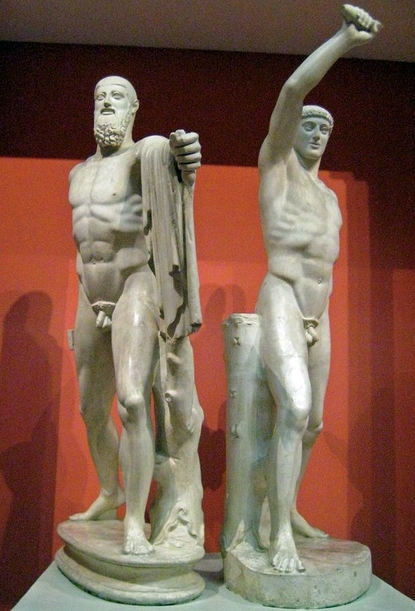
Aristogeton and Harmodius
(National Archaeological Museum, Naples)
Content created: 2018-12-02
File last modified:
In 514 Athens is under the control of a tyrant named Hippias. A man named Aristogeton and his lover, a younger man named Harmodius, decide to assassinate Hippias during the Panathletic procession, an event that had been instituted by Hippias’ father Peisistratus, who had preceded him as tyrant.
However, Aristogeton and Harmodius spot Hippias in conversation with a friend of theirs who knows of their plans, and they conclude that they are being been betrayed, so they flee the city.
As they leave Athens, they run into the tyrant’s obnoxious brother Hipparchus. Some say that Hipparchus had earlier coerced young Harmodius into having sex and/or had insulted Harmodius’s sister. Historians don’t know quite what happened on the road, but the encounter ends up with Aristogeton and Harmodius killing the annoying Hipparchus.
Shortly thereafter soldiers arrive, and Aristogeton and Harmodius are captured and killed.
The tyrant Hippias, worried, like all tyrants, about the security of his position, has became more and more oppressive. As a result, he is at last successfully overthrown. (He will be followed eventually by Cleisthenes, who will be acclaimed as the father of Athenian democratic constitutionalism.)

In the general enthusiasm over Hippias’ overthrow, the dead lovers Aristogeton and Harmodius are suddenly celebrated as early freedom fighters, martyrs of the fight against the hated Hippias.
A person who slays a tyrant is called a “tyrannicide”; so is the act itself of slaying a tyrant. The dead Aristogeton and Harmodius were celebrated as glorious tyrannicides. Slaying Hipparchus had nothing to do with overthrowing the tyrant Hippias, of course, and Aristogeton and Harmodius had been killed by Hippias rather than killing him, so they were his victims, not his tyrranicides. But masses are easily confused and everyone likes history to be simplified, even if no exams are involved, and especially if a love story can be mixed up in it.
Immediately the pair became objects of various patriotic works of art, showing them slaying Hipparchus/Hippias. (These are the earliest known illustrations of a documented historical event, as opposed to a mythological or legendary one, even if the facts are off.)
Songs are written celebrating them, and so many statues are produced that pretty much everybody can easily recognize a representation of young Harmodius with his right arm raised for a sword-stroke while Aristogeton stands beside him urging him on. (The frenzy of artistic production will continue well into Roman times.)
Vincent Azoulay’s book The Tyrant-Slayers of Ancient Athens: A Tale of Two Statues (Oxford University Press, tr. by Janet Lloyd, 2018), traces the artistic representations of Aristogeton and Harmodius as their symbolism moved from symbolizing both (1) erotic love and (2) the glories of liberation to symbolizing both (3) opposition to tyranny and (4) patriotic opposition to Persians in general and Persian invasions in particular. The statues kept multiplying and their interpretations kept mutating throughout Greco-Roman antiquity, so Azoulay has plenty of material to work with.
The pair of statues shown here is in the National Archaeological Museum, Naples. Similar representations were apparently common in the Greco-Roman world, although few survive. The note above is based on a review of Azouly’s book by James Romm (New York Review of Books, August 16, 2018, pp. 21-22.)